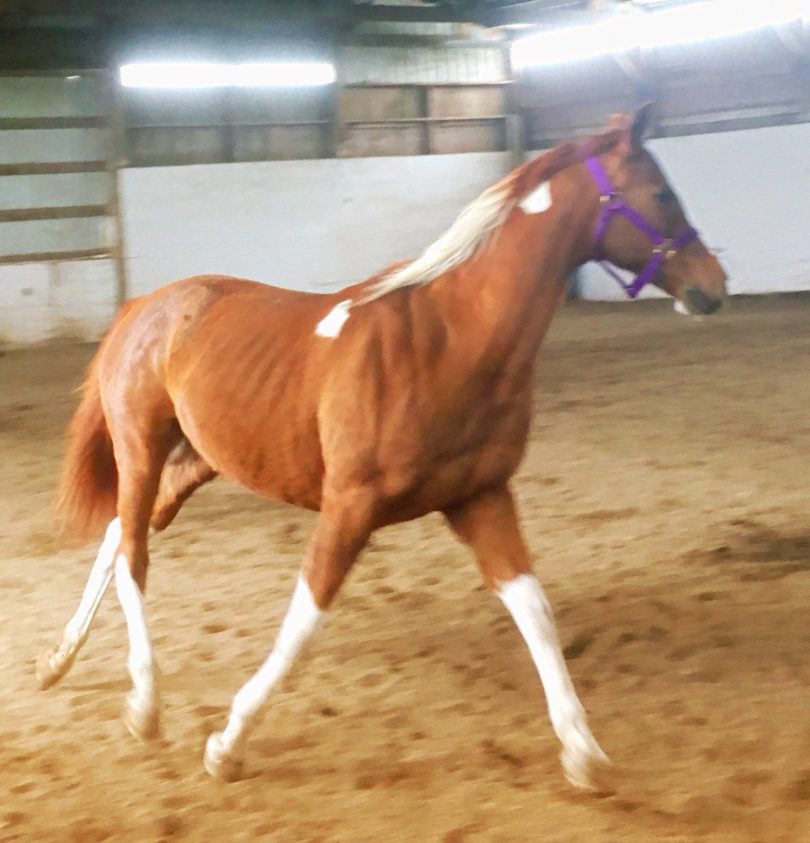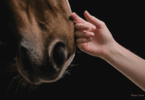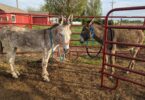Rose Begins to Bloom
Meet Rose, a vivacious, ten-year-old chestnut paint. Half Saddlebred and half Arab, she is every bit spirited as she is beautiful. Rose was born and raised in rural Idaho, where she was green-broken and mainly ridden on trails in the backwoods. She is incredibly sensitive, intuitive, and responsive.
Rose is affectionate by nature, as well as flighty and spooky. In addition, Rose tests boundaries constantly. She responds overwhelmingly well, however, to positive attention.
Rose moved to Washington state a little over a year ago. Because of the transition to the new environment, coupled with the years she went without being ridden, we will treat her as a green horse for all intents and purposes. This case study (plus part two) will explore various angles of horsemanship. I want you to join me as we track the progress—including the ups and downs—of Rose (and Chip parts one and two).
The Focus
Since Rose has mostly been ridden on trails, and that time was so long ago, the focus will be basic training. Sherry, her owner, and I will be working side-by-side to instill ground manners, walk her through her biggest fears, under-saddle training, and get her solid on the trails. Rose’s owner Sherry wants to make her steady trail horse.
The focus today will be to assess her training levels on the ground, on the lunge line, and under saddle to prepare an action plan around the goals above.
The Prep
Sherry groomed and tacked up Rose slowly. She was squirmy with the saddle, on par with how Sherry had described her behavior after a saddle incident that happened about eight months prior.
Sherry was patient with her and let her have time to relax this morning and get reacquainted. Rose took to the slower pace well and let herself be saddled without argument.
Lunge Line
Sherry then lunged Rose in both directions at a trot and canter. Counter-clockwise, she was energetic and spunky. Clockwise, however, she was clearly uncomfortable.
She pointed her nose outward towards the rail, and her body followed with hollow, disjointed movements.
She began to buck immediately when Sherry asked her to move from trot to canter. As soon as pressure was off her for the canter, she backed down from her bucking into a trot. Every time she was asked to canter, she began to buck more aggressively than the previous time.
Rose is a quick learner, and she’s already found “an out” from cantering in her weaker direction.
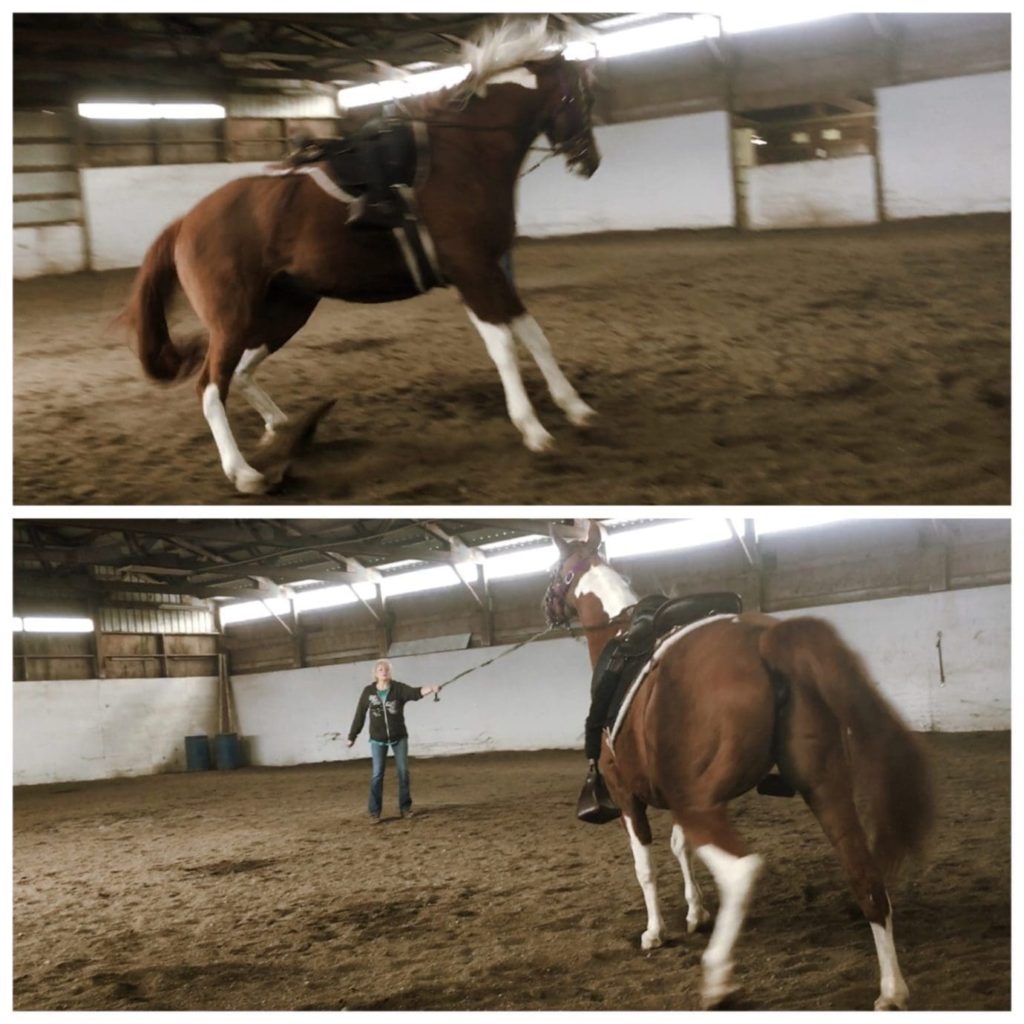
Photo Credit: Lindsey Rains
I encouraged Sherry to not take the pressure off when Rose started to buck — instead to wave the whip at her as soon as she slowed towards the trot. Rose responded to this with a disjointed canter-two-paces, buck-several-paces dance.
Yet, Sherry remained consistent and didn’t take the pressure off her until she said “trot” and eased her body language.
Reversing the direction back to counter-clockwise, Rose moved perfectly well from trot to canter and trot again. Sherry gave her a break by walking her around the arena, keeping her mind and manners engaged by practicing “hoa.”
And thus, the tides began to shift.
Rose, I’m learning, has a way of transforming through her sessions, and it happens quickly (as opposed to horses who transform over time). This is a remarkable thing to witness. Sherry went back to the lunge circle with Rose, back into her non-favored (clockwise) direction.
This time, I advised Sherry to get her into a relaxed jog at first. Rose was much more collected, focused, centered, and this time, bent toward the middle of the circle. Sherry then asked for a more forward trot. Rose obliged willingly. From that motion, Sherry waited a few beats for a harmonious moment to ask for the canter.
When she did, Rose lifted her back, lowered her head, then offered a confident transition into the canter!
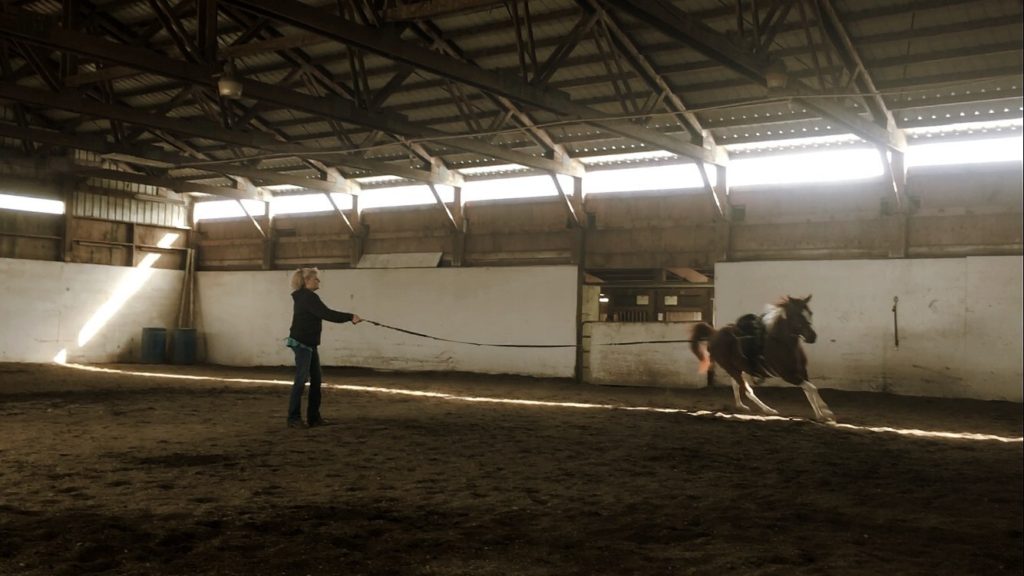
Photo Credit: Lindsey Rains
This was such a victorious moment for all of us involved.
Instead of using force, we had convinced Rose to partner and listen of her own volition. She then offered something more beautiful than what we had even asked for.
Furthermore, we saw a glimpse of her capabilities as an extraordinary mover. Sherry and I watched for hesitation to keep encouraging this pretty canter for a few strong laps around the circle, then relaxed her back into a trot, then a pleasant walk.
Rose was also much more responsive in the simple “hoa” on the lunge line.
And the Moment We’ve All Been Waiting For
Since a fall about a year ago, then an incident with the saddle about eight months ago (where Rose’s saddle was too loose and slipped underneath her on the lunge line), Sherry hasn’t felt safe or secure hopping on her back and moving forward with her under-saddle training.
She had decided that today would be the day when that changed.
Rose was calm at the mounting block. Sherry has been working with her, dropping the block all around her (so she could get used to the “thud!” and movement of it), and petting her from the block, putting weight in the stirrup, and so on. Alignment will still need some work, but that will come with time and more confidence. She stood very still for Sherry as she walked up and down the block, putting her weight in and out of the stirrup.
Sherry was nervous, and for the first time in this horse-and-rider relationship, I saw Rose take care of Sherry’s nerves. Sherry is typically the one making sure Rose feels safe, loved, secure. Today, Rose stood there for a good ten minutes while Sherry worked through her (understandable) nerves around riding her green horse.
I suggested to Sherry to tell her horse why she was nervous, and what was going through her mind. She told Rose plainly: “I’m afraid you’re going to move as soon as I swing my leg over and start freaking out once I’m on your back, even though you’re showing me that you are fine.”
With that out in the open, Sherry swallowed her fear and swung her leg over her horse.
Rose lifted her head, but kept an ear behind her to listen for Sherry’s voice. Sherry settled herself and squeezed Rose forward. We did everything today while leading her on the lead rope. I asked Sherry to have Rose “hoa.” Sherry drew her arms back quickly, then said “hoa!” Rose jerked her head up, and stopped moving forward but shifted side to side.
Our natural inclination as riders is to rely completely on the hand-bit connection, while staying rigid in our seat. Which, in turn, will foster anxiety in our horses.
All Rose had felt was a quick jerk to her mouth without warning and a loud command after the fact.
I challenged Sherry to think differently about “hoa.” I told her to engage her seat. Instead of going straight to the mouth and then saying “hoa,” to do the following:
- Take a deep breath
- Sink into her seat and heels
- Freeze her hips
- Say “hoa”
- Give a gentle tug on the reins
Sherry practiced it a couple times. It was awkward at first (it’s a lot to think and engage simultaneously), but after a few times doing this around the arena, she just took a deep breath, sank into her heels, and immobilized her seat, and Rose quickly hesitated into the “hoa,” before Sherry even said anything or touched the reins.
Now we know Rose has super-powers!
Ha, just kidding. But we both realized today that Rose is an incredibly responsive horse, and her sensitivity can be used to Sherry’s advantage, to where she will just think “hoa,” and Rose will pick up on it.
After this great victory, Sherry was beaming with pleasure.
Rose had pleased her, and was clearly relaxed and responsive in her body language. We walked back to the mounting block (to reinforce this a positive place). Sherry dismounted and rewarded her with a handful of cookies. Rose finished her day grazing in the back pasture.
Roadblocks and Issues in Today’s Session
When approaching a training program, it is invaluable to reflect on the session by identifying both the hang-ups and the victories. Both can inform the pathway to your desired goal. So initially, I’m going to address the roadblocks that arose today in our session.
Firstly, Rose was agitated and spooky during tack-up. The causes could vary from being in heat, her general temperament, weather changes, sensitivity to the saddle, or just going too long without being handled. Time will tell on this one as I gain more experience with her.
Secondly, her bucking fits on the lunge line seemed to me a big tantrum about being asked to canter her uncomfortable direction. This is understandable since she hasn’t been under saddle much in the last few years. I will not encourage this behavior, using more effective communication.
She eventually responded well, as you read, when Sherry remained consistent in asking her for the canter and making it less comfortable to throw her fit. By the end of the session, she was capable and comfortable moving at the trot and canter in her less-comfortable direction.
Thirdly, she is very pushy when being handled, even on the ground. The moment she is led out of her stall, she rushes forward without regard to anyone “leading” her until Sherry yanked on her rope and showed her that wasn’t okay.
Victories from Today’s Session
Her first victory was our breakthrough on the lunge line, as mentioned. Rose softened so much when she realized that her tantrum wasn’t getting her anywhere. The transformation in her body language from rigid, hollow, and intense to round, collected, and soft made her seem like a completely different horse. Her focus and attentiveness notably shifted mid-session.
Her second victory was her calmness at the mounting block. This encouraged Sherry that, contrary to opinions about Saddlebreds, she can retain her training quite well. I would attribute this to Sherry’s positive reinforcement when working with her over the past months at the mounting block.
A little affection goes a long way with Rose, and their bond keeps growing stronger.
Finally, Rose proved to be marvelously responsive to seat-cues when working on “hoa” under saddle. She is clearly a quick learner and eager to please.
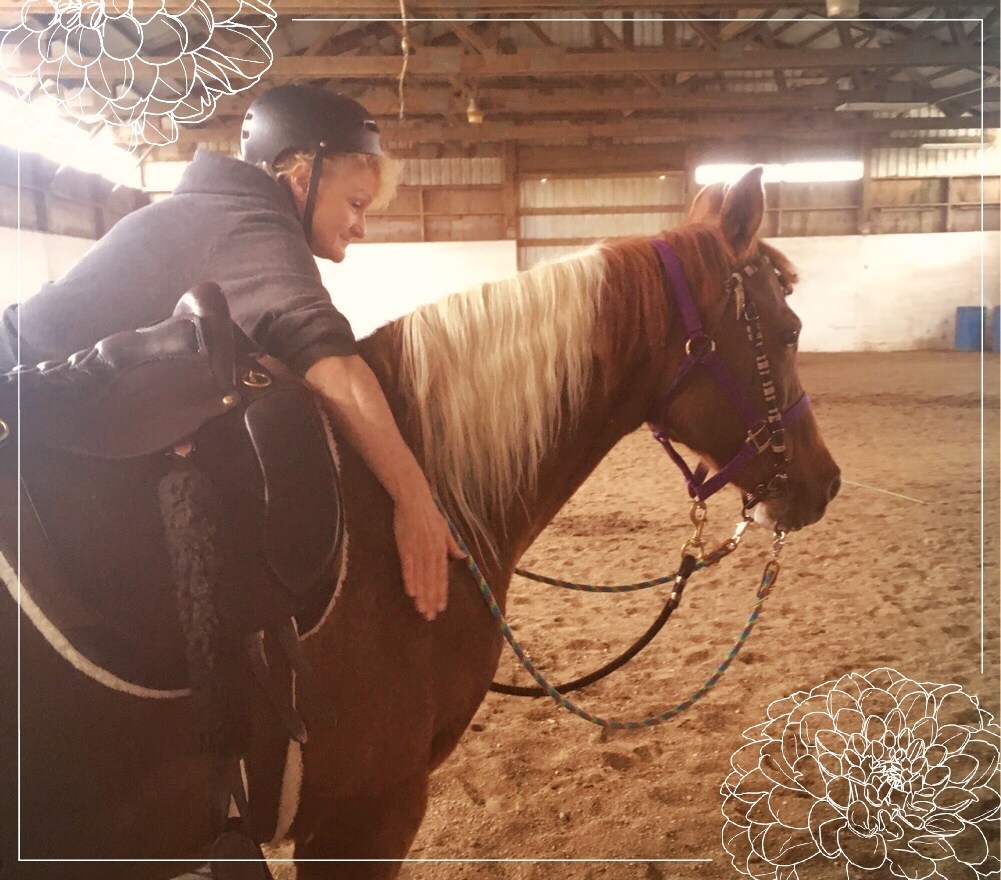
Photo Credit: Lindsey Rains
Going Forward
I like to end sessions with a plan for the next session. This is something I never did until I got my own horse and became responsible for his training. I always relied on trainers to show me what to do, rather than think of goals, solutions, and plans for my horse’s development.
Even having a loose plan for your horses can improve your experience with them and foster growth in their capabilities.
Keep it simple, don’t hold too many objectives at once. Think of steps that can be building blocks for future training.
For Rose, I’d like to focus on the following things:
- Reinforcing personal space on the ground. Currently, whenever we handle her, we will need to reinforce that she cannot walk past a certain point in relation to her handler, and that when we say “hoa,” she needs to stop. This will be crucial for safety, especially when something frightens her.
- Lunge line responsiveness. “Hoa” should become just as important on the lunge line, especially in preparation for riding her on the trails. I’d also like to see her be responsive on the lunge line, not reactive, even in her uncomfortable direction.
- General desensitization. I’d like to see her comfortable and relaxed while being tacked up. She is still jumpy to farm equipment, cats and dogs, her saddle, and extraneous noises.
- Under-saddle basics. The first step to making her a solid trail horse is getting her comfortable and responsive under saddle. Until she gets the basics down at a walk and trot, we won’t even touch finishing work or the canter under saddle.
Rose seems to respond well to firm boundaries and excessive praise. She needs to know when she has crossed a line, but more importantly she needs to know that she is doing well. As spirited as she is, she is driven by connection, more so than other horses I have encountered. It is important right now to remember that though she is ten years old, she is still very green.
I want to allow every horse the grace and space to learn.
I want to learn how much “training” she can handle, and focus on building that horse-and-rider bond with simple care and handling. There is no rush when creating a fine horse. Each needs their own time and space framework to learn. But rest assured, they will get there.
P.S. Enjoy this article? Trot on over to:
- 32 Things you can do today to calm your riding nerves forever
- Scared to ride your horse? Get your mojo back
- How can I calm my nerves before horse riding?
- What are some ways to gain confidence riding horses
- Safe or sorry: how often to replace horseback riding helmets

